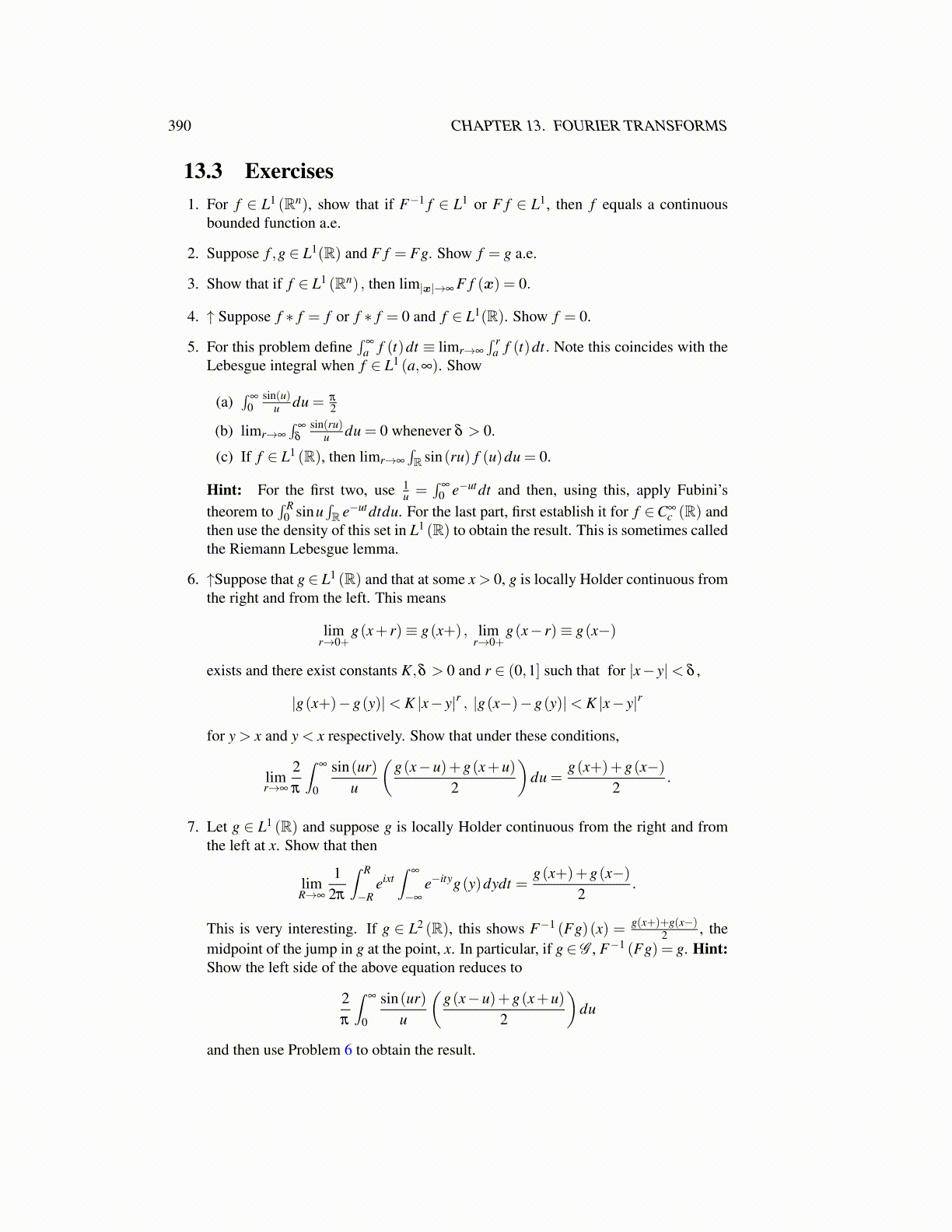
390 CHAPTER 13. FOURIER TRANSFORMS
13.3 Exercises1. For f ∈ L1 (Rn), show that if F−1 f ∈ L1 or F f ∈ L1, then f equals a continuous
bounded function a.e.
2. Suppose f ,g ∈ L1(R) and F f = Fg. Show f = g a.e.
3. Show that if f ∈ L1 (Rn) , then lim|x|→∞ F f (x) = 0.
4. ↑ Suppose f ∗ f = f or f ∗ f = 0 and f ∈ L1(R). Show f = 0.
5. For this problem define∫
∞
a f (t)dt ≡ limr→∞
∫ ra f (t)dt. Note this coincides with the
Lebesgue integral when f ∈ L1 (a,∞). Show
(a)∫
∞
0sin(u)
u du = π
2
(b) limr→∞
∫∞
δ
sin(ru)u du = 0 whenever δ > 0.
(c) If f ∈ L1 (R), then limr→∞
∫R sin(ru) f (u)du = 0.
Hint: For the first two, use 1u =
∫∞
0 e−utdt and then, using this, apply Fubini’stheorem to
∫ R0 sinu
∫R e−utdtdu. For the last part, first establish it for f ∈C∞
c (R) andthen use the density of this set in L1 (R) to obtain the result. This is sometimes calledthe Riemann Lebesgue lemma.
6. ↑Suppose that g∈ L1 (R) and that at some x > 0, g is locally Holder continuous fromthe right and from the left. This means
limr→0+
g(x+ r)≡ g(x+) , limr→0+
g(x− r)≡ g(x−)
exists and there exist constants K,δ > 0 and r ∈ (0,1] such that for |x− y|< δ ,
|g(x+)−g(y)|< K |x− y|r , |g(x−)−g(y)|< K |x− y|r
for y > x and y < x respectively. Show that under these conditions,
limr→∞
2π
∫∞
0
sin(ur)u
(g(x−u)+g(x+u)
2
)du =
g(x+)+g(x−)2
.
7. Let g ∈ L1 (R) and suppose g is locally Holder continuous from the right and fromthe left at x. Show that then
limR→∞
12π
∫ R
−Reixt∫
∞
−∞
e−ityg(y)dydt =g(x+)+g(x−)
2.
This is very interesting. If g ∈ L2 (R), this shows F−1 (Fg)(x) = g(x+)+g(x−)2 , the
midpoint of the jump in g at the point, x. In particular, if g ∈ G , F−1 (Fg) = g. Hint:Show the left side of the above equation reduces to
2π
∫∞
0
sin(ur)u
(g(x−u)+g(x+u)
2
)du
and then use Problem 6 to obtain the result.